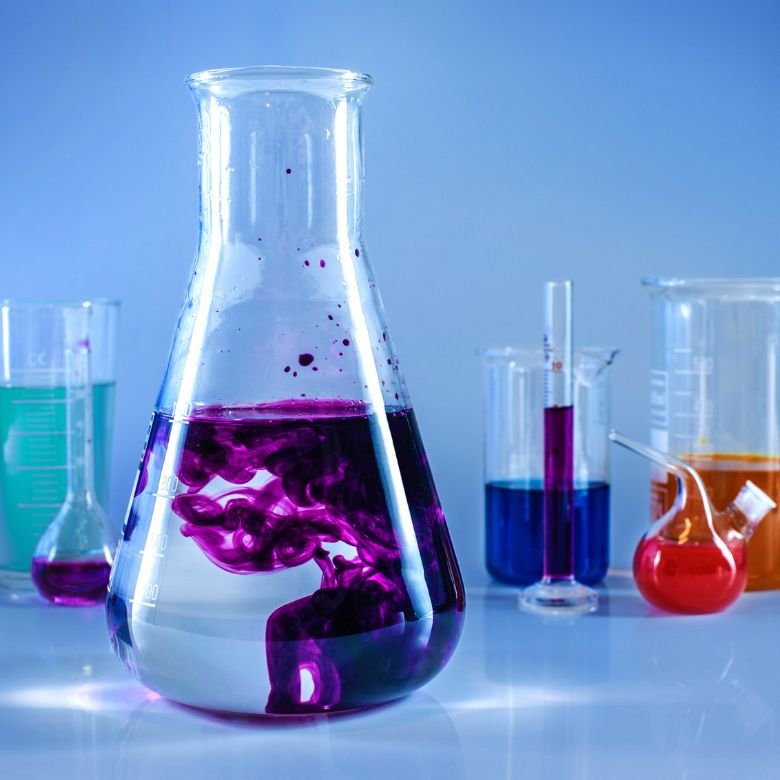Hydroxides are an important group of chemical compounds. Their chemical properties are mainly based on the fact that their molecules contains a hydroxyl group which gives them a basic pH. Hydroxides are commonly applied in the chemical, plastics and tanning industries as well as in construction.

Hydroxides
Hydroxides are substances that are widespread in our daily lives. They play an important role in many industries, acting as raw materials or semi-finished products in various processes. What should we know about them?
- they are built of the cations of metals (or ammonium group, NH4+) and one or more hydroxyl groups;
- the OH– is characteristic to hydroxides and gives them special properties;
- the name of each compound is made by complementing the word ‘hydroxide’ with the name of the element that it contains;
- hydroxides exist in the solid state of aggregation;
- we distinguish basic hydroxides (which react with acids, do not react with bases, are freely soluble in water, and show high hygroscopicity) and amphoteric hydroxides (which react with bases and acids, are slightly soluble in water, and are non-hygroscopic);
- the water-soluble hydroxides undergo electrolytic dissociation when put into water.
What is the difference between hydroxides and bases?
In chemistry, bases are all hydroxides that are soluble in water. However, not all of these compounds are prone to reaction with water molecules. The sodium or potassium hydroxides are freely soluble, so we can call them bases: a sodium base and a potassium base, respectively. It is quite different with the iron(III) hydroxide (Fe2(OH)3), which is slightly soluble in water and so cannot be called a base. It is similar in the case of copper(III) or silver hydroxides, as they precipitate from aqueous solutions in the form of deposits. The solubility of particular hydroxides can be checked in the salt and hydroxide solubility table.
We should note that not every hydroxide is a base, but every base is a hydroxide.
Bases are all hydroxides of the metals from the first group in the periodic table (the so-called lithium group) as well as a few metals from the second group (calcium, strontium, barium). An exception is the ammonium base, which is the only base whose molecules do not contain a metal atom.
Bases, as chemical compounds, are freely soluble in water, and in aqueous solutions they undergo electrolytic dissociation, decomposing into cations and anions. The produced ions are capable of conducting electric current. Therefore, bases are also electrolytes.
The decomposition of hydroxides into ions also affects their ‘basic character’. The presence of a base in an aqueous solution increases its pH level, so the concentration of hydroxide ions OH– decreases. The amount of these anions can be determined by measuring the pH of the tested solution with an appropriate ion-selective electrode. We can also assess the pH visually by adding a proper indicator to the solution or immersing an indication paper, which will turn green or dark blue in the presence of bases. The most popular indicator used to detect bases is phenolphthalein – in the aqueous solutions of hydroxides, it turns a characteristic raspberry colour.

Sodium hydroxide
The most commonly used hydroxide is sodium hydroxide (NaOH). It is commercially available in the form of tablets or granules. It should not be stored in glass vessels, in particular those with a plug. Instead, there are dedicated polyethylene containers. It is very soluble in water (the process is heavily exothermic), and thus classified as a strong base. When working with NaOH, we should exercise particular caution due to its irritating properties.
On a laboratory scale, NaOH is acquired by reaction between (metal) sodium with water. If we add sodium to a beaker filled with water and phenolphthalein (indicator), the raspberry colour will appear, indicating the presence of OH– ions. At the same time, hydrogen will be released. In industry, the sodium hydroxide (caustic soda) is obtained by electrolysing the aqueous solution of sodium chloride. The process causes the secretion of chlorine on the anode, while the cathode gets surrounded by sodium hydroxide. Another industrial method of acquiring that base is the so-called mercury method. The sodium amalgam and mercury precipitating on the cathode are placed directly in a container filled with water.
Sodium hydroxide plays a great role in industry. It is an important chemical reagent used on a daily basis in laboratories. It is one of the components used to produce plastics, rubber, paper, and cleaning agents. It is also has a role in the processing of crude oil.
Calcium hydroxide
When compared to NaOH, calcium hydroxide (Ca(OH)2) has two hydroxyl groups. It is much less soluble in water – a saturated aqueous solution of that compound is called ‘limewater’ (phenolphthalein dyes it the raspberry colour and produces a basic pH). Limewater is widely used for detecting carbon(IV) oxide (the so-called turbidity of limewater).
In laboratory conditions, it can also be obtained by reaction between calcium and water. However, that reaction is much milder. Calcium hydroxide produced on an industrial scale is acquired in an exothermic process called ‘lime slaking’.
The main industry using calcium hydroxide is construction, where it is an ingredient of lime mortar. It is also used for producing artificial fertilisers. In sugar production, the compound is used for purifying beet juice. Given its chemical nature, Ca(OH)2 is also used for disinfection.
Examples of other hydroxides
Apart from the sodium or calcium hydroxide, an important role is also played by the combinations of a hydroxyl group with other metals.
In terms of its structure and properties, potassium hydroxide very much resembles the NaOH. It is also a strong base. It reacts violently with water and shows high hygroscopicity.
Both magnesium oxide and aluminium oxide (Mg(OH)2 and Al2(OH)3) can be applied as drugs against stomach hyperacidity. Additionally, magnesium hydroxide is used as an ingredient of most toothpastes.
Iron(III) hydroxide is one of the substrates used to produce pigments. It is also applied in wastewater treatment processes.